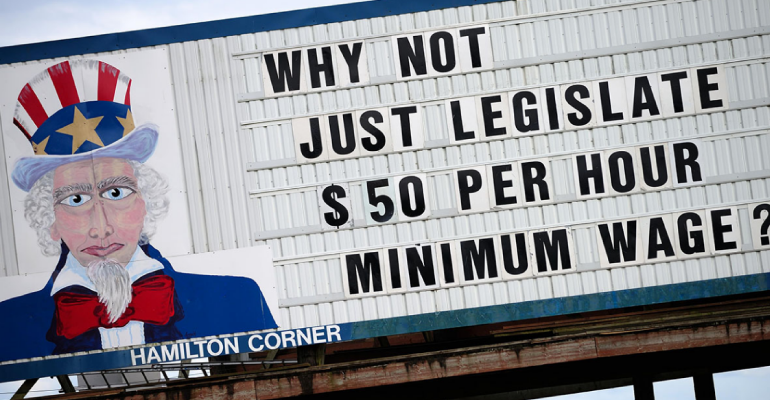
President Obama is pushing an increase in the minimum wage to $10.10 from $7.75 per hour. Left centered cities are passing $15.00 an hour minimum wage legislation. These proposed increases are a distraction, a head fake, to divert attention from the fact that 92 million Americans discouraged by not finding jobs are no longer in the labor force (Bureau of Labor Standards, “Table A-16, Persons not in the labor force and multiple job holders by sex , not seasonally adjusted,” http://www.bls.gov/news.release/empsit.t16.htm); the largest number in American history have stopped looking because of the dearth of jobs created under the Obama administration.
First, let’s understand that the minimum wage pertains to entry level jobs, jobs for teenagers and young adults lacking work experience, education, and maturity. Second, the minimum wage was not designed to support a family of four!
Two other important conclusions were drawn by Neumark and Wascher’s: “First, we see very few – if any – studies that provide convincing evidence of positive employment effects of minimum wages, especially from those studies that focus on broader groups (rather than a narrow industry) for which the competitive model generally predicts dis-employment effects. Second, the studies that focus on the least-skilled groups are likely most directly affected by minimum wage increases provide overwhelming evidence of stronger dis-employment effects for these groups.”
This is a basic economic fact: raise the price of a product or service and demand will go down. Neo-progressive drones ignore the facts and accuse their opponents of hating poor people. This is the typical, irrational touchy-feely empathy argument of the left. For Democratic drones, there is no minimum wage high enough. So let’s take a look at the myths of the minimum wage (Mike Flynn, “Top Five Myths About the Minimum Wage,” http://www.breitbart.com/Big-Government/2013/03/10/top-5-myths-about-the-minimum-wage):
- Hiking Minimum Wages Boost the Economy – In 1979, almost 14% of hourly paid workers earned the federal minimum wage. Today, that number is 4% of hourly paid workers.
- Minimum Wage Workers Are Poor – Just over 11% of workers who would gain from an increase live in poor households. Over 63% of workers who would gain are second or third earners in families making well over the federal poverty line. In a different measure, 43% of workers who would benefit live in households with income over $50,000 annually.
- Minimum Wage Workers Are Supporting a Family – Census Bureau data confirm that 40% of the beneficiaries of the 2009 minimum wage increase were teens or others living with a parent or relative (Employment Policies Institute, “Just Getting By? Income Dependence on Minimum Wage Jobs,” http://www.epionline.org/study/r132/). Research has shown that long-term minimum wage earners, a sliver of all (workers, often lack basic job skills needed to move up in the workforce . . . raising the minimum wage in an attempt to help this small subset can actually harm them . . .” ([1]Employment Policies Institute, “Just Getting By? Income Dependence on Minimum Wage Jobs,” http://www.epionline.org/study/r132/).
- A federally mandated wage hike is the only minimum wage workers get a raise – Nearly two-thirds of all minimum wage earners receive a raise with the first twelve months on the job.
- A mandated wage hike is the best way to improve income for minimum wage workers who are poor – In the 1970s, the Earned Income Tax Credit was passed into law. Low-income households receive a refundable tax credit, the amount of which is based on their other income. It acts as a guarantee of minimum income, rather than a minimum wage.
Documented proof that minimum wage requirements are destructive: smaller Seattle restaurants are closing down (http://www.inquisitr.com/1924418/seattle-15-minimum-wage-forcing-some-restaurants-out-of-business/) because they cannot afford to pay employees $15 per hour (http://hotair.com/archives/2015/03/14/seattle-eateries-closing-as-15-minimum-wage-approaches/).
In New Jersey, small businesses facing a $15 per hour minimum wage are faced with two choices: increase prices or cut employees’ hours and jobs (https://www.tapinto.net/categories/press-releases/articles/15-minimum-wage-will-hurt-small-businesses-njbi)
In summary, the minimum wage is a price control on labor and price controls always have an adverse effect on the economy. This is why minimum wage laws adversely impact the entry-level worker. “A majority of economists surveyed in in Britain, the United States, Germany, Canada and Switzerland agreed that minimum wage laws increase unemployment among low-skilled workers. In the United States 90% of economists agreed with this fact, in Canada 85% agreed” (The Political Order, “The Myth of the Minimum Wage,” http://thepoliticalorder.blogspot.com/2013/01/the-myth-of-minimum-wage.html)
